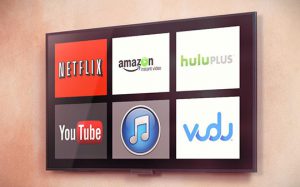Advanced TV on the rise
 As consumers, we are adding different devices into our households that enable us to consume more media each day. Smart TVs, Apple TV, Roku and video game consoles were among the top gifts this past holiday season, and for good reason! These devices are providing access to online-based services such as Netflix and Hulu, which giveus an alternative to broadcast and cable TV.
As consumers, we are adding different devices into our households that enable us to consume more media each day. Smart TVs, Apple TV, Roku and video game consoles were among the top gifts this past holiday season, and for good reason! These devices are providing access to online-based services such as Netflix and Hulu, which giveus an alternative to broadcast and cable TV.
More and more people are cord-cutting, and opting out of traditional cable TV services. According to a 2Q17 Nielsen Total Audience Report, almost 60% of U.S. homes (or 69.5 million households) own at least one internet-enabled device. That is a 12% increase from a year prior, and we expect that number to continue to rise. What kind of TV viewer are you? Cord-cutter, binge-watcher, On-Demand streamer, tablet watcher, the good ole fashioned live TV viewer, or all the above? For traditional television advertisers, an updated strategy to combat the increasingly fragmented video landscape is a necessity. To effectively reach an audience, advertisers must incorporate more than just linear TV into a video strategy.
This is where advanced TV can come in. Identified as the universal term for all forms of TV not watched through a broadcast, cable or satellite connection, advanced TV has created a new way for advertisers to reach their target audiences by combining the impact of TV with the accuracy of digital. Designed to replicate a 15- or 30-second TV spot, advanced TV enables commercials to be shown digitally. Including a broad spectrum of premium content offerings at multiple reach and price levels, advanced TV is bringing the best of the digital and linear TV advertising worlds together. Advanced TV video options can include connected TV, addressable TV, programmatic TV, TV Everywhere and Video on Demand, just to name a few. Depending on what a marketer’s campaign goals are, considerations should be made based on what type of advanced TV would be best. These advanced TV options can be scaled according to a preferred geographic area, demographic and behavioral data, budget constraints and other campaign goals. Naturally, the consumer context and experience would define each advertiser’s approach.
Nielsen confirms that overall, media usage among U.S. Adults 18+ has increased by more than 30 minutes in the past year and that trend will continue. Further, the use of multimedia devices, including connected TVs, increased by 111% over the last two years, from nine minutes to 19 minutes. Consequently, it is becoming ever more important for advertisers to be proactive when planning their video strategy.
Although linear TV currently remains the largest reach video channel, media trends show that new technology and changing consumer habits will continue to erode its reach and overall effectiveness, particularly among the younger demographics.
While some may still see a linear TV-only strategy as the best way to reach their audience, most will be considering a multi-platform approach to ensure that their message is on every screen to reach every category of TV viewer in this ever-evolving video landscape.

